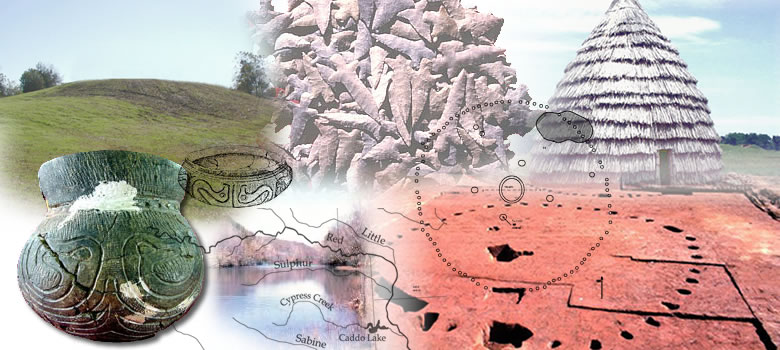Uncovering Early Caddo History

This exhibit traces the early history of the ancestors of the Caddo people from dim patterns thousands of years old through the Caddo era of greatness from about A.D. 800 to the late 1700s. Most of the evidence comes from the ground, uncovered by archeologists in many places across the Caddo Homeland. Here we try to summarize what has been learned and attempt to answer some very difficult historical questions:
- When did the Caddo and their immediate ancestors first occupy their traditional homeland?
- When, where, and how did distinctly Caddo culture originate?
- What was life like for Caddo ancestors, especially during the long era of Caddo greatness?
- How and why did Caddo societies change through time?
These questions are difficult to answer because they are so BIG and because we are asking about things that happened long before written history. Nonetheless, in this exhibit we do our best to answer these questions, summarize the evidence upon which most of our inferences are based, and point out what more we need to know.
Most of the sections making up this large exhibit follow history from earliest times to latest. While each section is meant to stand on its own, the overall story is an historical narrative that can be understood best by following the sections in chronological order. To make this easy, simply click on the "Follow Caddo History" button at the bottom of each section. Parts of the story discuss matters in more detail than readers may have time or interest in. Thus, we use Sidebar pages in the Caddo Ancestors exhibit that you can bypass or follow to learn more. The Sidebar pages are mostly text.
Here is a brief description of each of the main sections in the suggested reading order:
- Tracing Early Caddo History: brief introduction to the major challenges facing anyone who seeks to understand the early history of Caddo ancestors.
- Those Who Came First: overview of the early peoples who lived in and near the Caddo Homeland during the Archaic era, prior to about 500 B.C. The distant ancestors of today's Caddo were probably already living in the area, but they are hard to identify.
- Woodland Cultures: a lengthy section with several subsections covering the period between about 500 B.C and A.D. 800 during which the ancestors of the Caddo and their neighbors developed or adopted many of the characteristics of later Caddo life: sedentary settlements, gardening, pottery making, long-distance exchange of ritual items, mound building, and complex community-oriented ceremonialism.
- Early Caddo: lengthy section with several subsections on Formative (or Emerging) Caddo (A.D. 800-1000) and Early Caddo (A.D.1000-1200) periods when Caddo culture developed as a unique expression of the larger Southeastern cultural tradition. The Crenshaw site in Miller County, Arkansas, and the George C. Davis site in Cherokee County, Texas, are used to help explain the emergence and crystallization of the Caddo cultural tradition.
- Middle Caddo: the Oak Hill Village site in Rusk County, Texas, provides an unusually complete look at a small Caddo settlement.
- Late Caddo: review of the latest prehistoric period (A.D. 1400-1680) during which Caddo culture reached its apogee and Caddo peoples lived in villages, hamlets, and farmsteads throughout the entire Caddo Homeland at all-time high population levels.
- Titus Phase: Caddo Farmers in Northeast Texas, A.D. 1430-1680: More-detailed look at one local area and period for which we now know a great deal about life during Late Caddo times.
- Early Historic: overview of that portion of the early historic era (A.D. 1680-1835) during which Caddo life was fundamentally altered and all but destroyed by the impact of European colonization and its consequences.
- Credits and Sources: acknowledgments of the many contributors to this exhibit as well as where to turn to learn more.